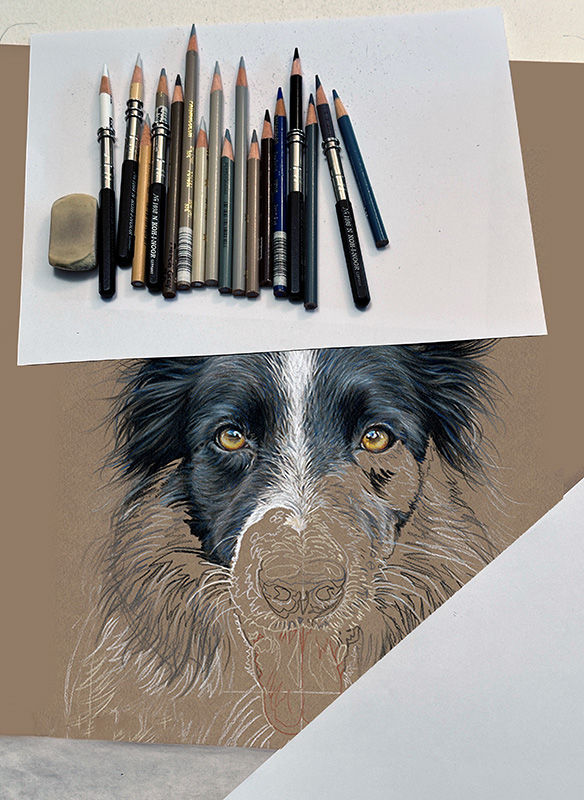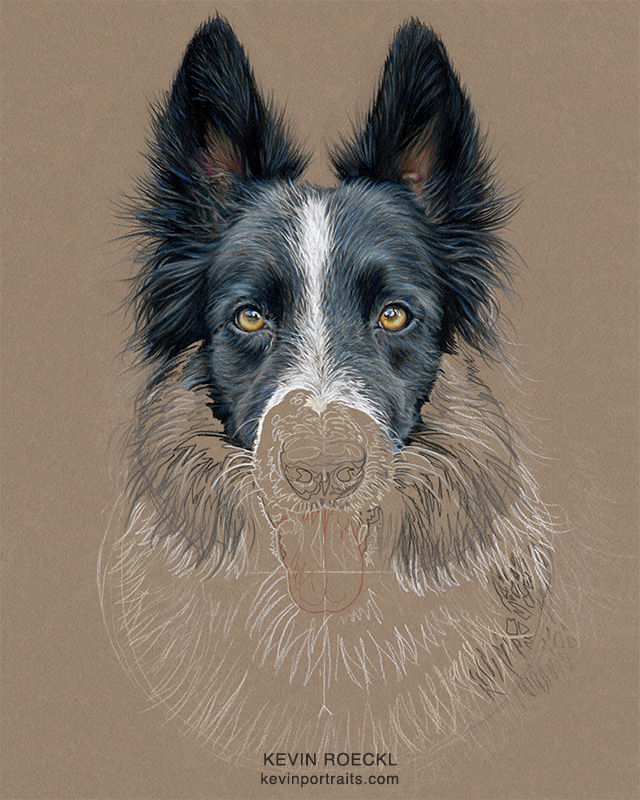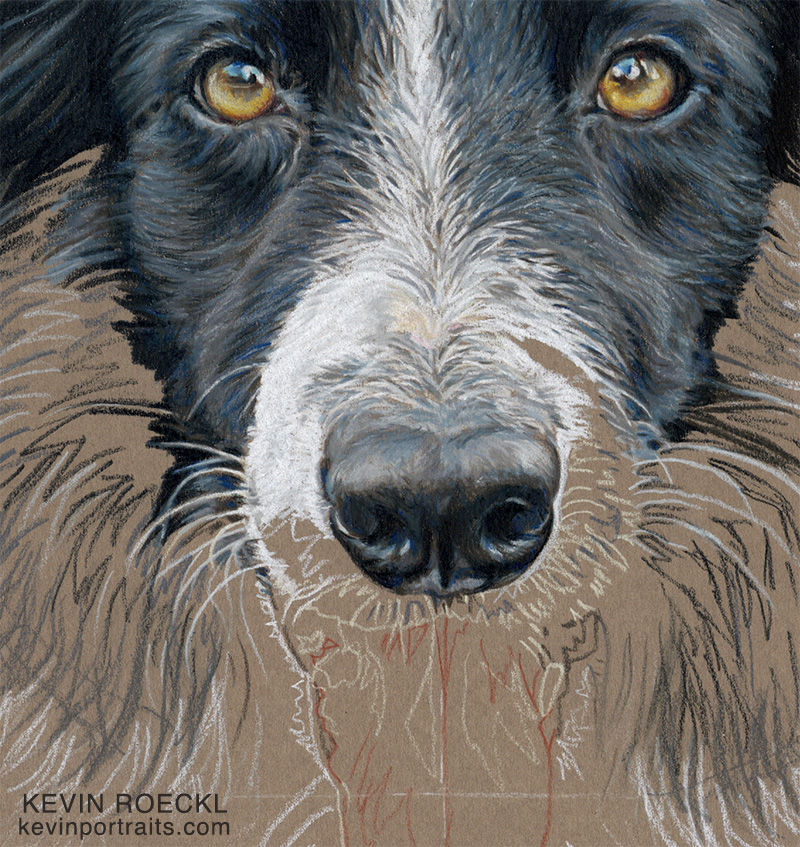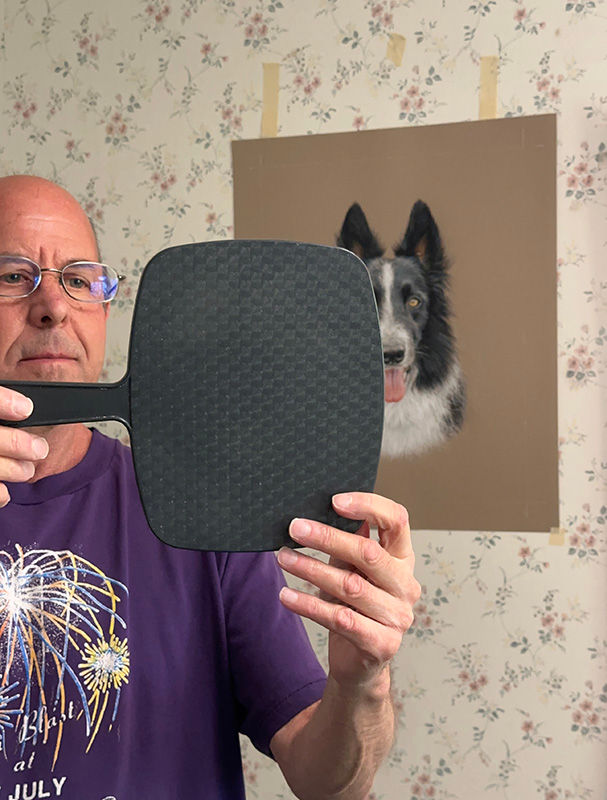Raven portrait in progress - start to finish
- Kevin Roeckl
- Jul 28
- 14 min read
June 20
I’m starting a new portrait, of Raven. This is the 4th Border Collie portrait I’ve done for Cathy Nearman. Soon I’ll share more of what Cathy wrote about Raven. But for now I want to share this about his “big puppy ears” and the three portraits of Storm, Jet, and Robin I created for Cathy.
“Raven grew up with Storm, Jet and Robin and had the time of his life with loads of fun!
He was very lucky to have them in his life growing up.
Oh what fun they had as Raven grew into those big puppy ears!”
1
This is baby Raven playing with Jet (left) and Storm.
And the 3 memorial portraits I’ve done for Cathy, starting with Robin (center) in 2016.
The portraits are Jet, Robin, and Storm. Raven is still alive and well at age 10.

2
Young Raven with “big sister” Storm…

3
You can see what Cathy meant by “growing into his big puppy ears”!

4
Both ears finished in the current portrait of Raven.

🎨 Prismacolor pencil on “Sand” Canson Mi-Teintes paper, 16 x 20 inches.
Commissioned by Cathy Nearman.
“Raven”
Conant’s Raven Nevermore CDX RN, bred by Sheila Conant.
Raven portrait in progress 2
1
Working on Raven’s eyes - so important in a portrait.
It’s particularly important to get the colors and values accurate in this one, because Raven has such unusual and striking eyes.

But what color are these eyes, really?
2
To find out I sampled some of the colors in Raven’s eye in the reference photo with Photoshop. and put them on the background paper color. Now I can get a sense of what colors those actually are, and their relative values compared to the paper color. The colors are barely different from the paper color. I thought the values would be a lot lighter. Didn’t you?

3
These are the pencil colors I pulled out to use. I made swatches on the “Sand” Canson paper I’m using, to see how they look on the paper. I want to know how the values compare. The value of the paper will guide me in how much lighter or darker to go in the different parts of Raven’s eye. And also because colored paper changes the color of the pencils that are over it.
You may notice that these colors are brighter (more saturated) than the sampled swatches on Raven’s reference photo. I will tone these colors down some. But not as much as the reference swatches. To my eye they look brighter than that. An artist’s “eye”, the way we choose to interpret what we see, is more important than a scientific accuracy to digital measurements.
The digital measurements are a tool. They inform what I see, and guide my pencil choice.
But I am the artist, not my computer.

4
The finished eye. And some of the surrounding structures - the shapes and values that help me contain and contrast the eyeball itself.
Nerve wracking. One full day’s work in the studio. But I think I’ve got it right.

5
At work in the studio. Coat colors on the left, eye colors on the right.

Raven portrait in progress 3
An artist should always improve upon their reference photo. Artists: Don't be a slave to what you see in your reference photo. I've improved on my reference photo by making Raven’s mane symmetrical. Here's how I did it....
1
I was going to start working on the ruff of hair (the “mane”) to the left side of Raven’s face today, working downward from that left ear. But I realized there was an issue with the reference photo. So I paused my pencilwork to correct that on my line drawing, the pencil outlines that guide me in the portrait.
This is the artwork that I started with:

2
This is my reference photo. A great photo of Raven’s eyes and expression, and his beautifully symmetrical face, looking straight into your soul. But can you see the problem with his mane? (The fringe of black hair on either side of the face.)
I have many other reference photos of Raven that Cathy sent at the beginning. In many of those I see a beautiful symmetrical mane, with the hairs flowing outward in a distinctive way. This photo doesn’t have that.

3
This photo is a beautiful example of the shape of his mane, which I saw in many other shots also. Almost like “butterfly wings”, with an upper and lower wing on either side of his face. Much prettier, don’t you agree?
This photo is not the expression Cathy wanted for Raven’s portrait, but it’s the right reference photo for his mane. I’m using other photos of Raven to create a “more perfect” mane framing his face. That will really add to the visual appeal of the portrait. Every client wants their loved one to look perfect in a portrait. It’s a portrait artist’s job to accomplish that.

An artist should improve upon the reference photo whenever possible.
Don't be a slave to what you see in your main reference photo.
We are artists, not copyists.
4
This is the modified mane on my line drawing. (In the next pic I’ll show you before and after). Note that I’ve drawn a vertical centerline up the center of Raven’s face with white chalk pencil (easy to erase) so I can measure outward from there and make sure the black mane on both sides is symmetrical. Raven’s portrait is strikingly symmetrical, with Raven looking directly at you; he has a very symmetrical face and markings. To capture the beauty of him, I want to get the shape of the mane perfectly symmetrical also.

That little arrow shape at the bottom of my chalk centerline is so I can see that’s an artificial line, not just another strand of white hair on my outline drawing. That helps orient me visually. I’ll erase that later.
5
This is my line drawing BEFORE and AFTER. On the left is the original line drawing from the main portrait reference photo, which doesn’t show his mane at it’s best.
On the right is the improved line drawing after I studied other reference photos of Raven. The black arrows on this pic show some of the main changes. The distinctive “upper butterfly wings” of hair that stick out below his ears on either side, then below that a gap (the same on both sides), then the large mass of black mane flowing out evenly on both sides in two matching symmetrical curves. In the previous pic you can see I drew those symmetrical curves pretty heavily with dark grey pencil. I’ll follow those grey curves when I make the outward-flowing hairs with pencil strokes.
See the difference in my before and after drawing? It’s minor, but it will make an important improvement in the visual appeal of the portrait.

6
These are some of the reference photos I was looking at to see Raven's ideal mane.

7
Ref photos on my monitor as I begin working downward from his ear on the left side. The larger one is the main photo I’m looking at for the perfect mane.

On the artwork I have the right eye covered with clean paper so I don’t drag my hand through that carefully crafted eye pencilwork, as I make the vigorous strokes with black pencil flowing outward to the left. Fast, vigorous strokes to make those sweeping hairs that come outward in the “upper butterfly wing” shape.
8
Working downward along the left side of the face. Pencils in their action-positions above the drawing!

Raven portrait in progress 4
The importance of landmarks:
1
Raven's forehead and around the eye-socket on the left side are finished. I’ve put in Raven’s center white stripe down his nose as a “landmark” so I can get the right side symmetrical after finishing the left side. Raven has such a symmetrical face, and the lighting is very even. I want to make sure the shape of his face and head doesn’t end up looking lopsided. Often the lighting is stronger on one side of a subject’s face and the shapes and values (lightness/darkness) are not symmetrical. But in Raven’s portrait they are. The lighting on his cheekbones, forehead, eyebrows, ears….is very even and symmetrical on both sides of the face. That’s unusual in a reference photo for a portrait. So to maintain that perfect symmetry, in this portrait I’m measuring everything out from the center line.

That centerline is an important tool in this portrait. Not something the client will ever be aware of. But it’s something I’m using to give her the most perfect portrait I can.
2
Now I'm filling in the shapes around Raven’s right eye (below). All of the complex shapes that make up the upper and lower eyelid, the eye socket, the eyebrow, and where those shapes attach to the forehead above, the bridge of the nose to the left, and the cheek below.
All of those shapes represent structures that are actually present in the anatomy of the dog's face. They are abstract shapes (artistically) but they mean something. They all lend themselves to the dog’s expression. If you don’t understand what those shapes represent, and how they affect the expression, it will be hard to get the expression just right.

To keep myself oriented with what I see in the reference photo, I create "landmarks", like the dark shadow of the cheekbone below the eyesocket. And the curved highlight of the upper and lower eyelid. Then I fill in around those landmarks, gradually attaching all the shapes together.
3
This is how the whole portrait looks now.

Raven portrait in progress 5
Raven has such a beautifully symmetrical face, and I have put a lot of attention on getting that symmetry even on both sides of his head. Today I saw that his muzzle is NOT symmetrical.
1
This is what I started with when I began work in the studio today.
When I began working on the black area of the right cheek today (below the right eye), I had to first outline the right side of his white muzzle, as I did on the left. (Giving myself a white edge to work up to.) Then I saw that his muzzle was NOT symmetrical.

2
These are the reference photos I pulled out to look at, in addition to the main reference photo I'm using for the portrait. In my main ref photo it looks like Raven has a white muzzle that’s just in shadow on the right side.
This is why it’s very important for portrait artists to look at more than one reference photo of their subject, showing the features in different lighting, and at different angles. So you can clearly understand what you are seeing in your primary photo. Photos can be deceptive, lighting and shadows can make the forms of the face look different than they are. This additional reference photo on the far right, in particular, with Raven’s head turned to the side, really shows me the markings on that side of his muzzle clearly.

3
Now when I outline that side of Raven’s muzzle, I understand what I need to capture. I know what I need to do with my pencils. Notice I have not used white pencil to outline the right side of the muzzle like I did on the left. I know that I’ll be working into grey and black values as I go down that right side.
Next I’ll start filling in the white muzzle on the left, inside the white outline I made. That white outline captures the little white hairs and white whiskers that stick out into the black cheek area (on the left side and the upper right). I had to create that white outline with those hairs and whiskers, so that I could work up to that white edge with the dark grey and black pencils I used to fill in both lower cheeks.

I needed that white edge before I could complete the black cheeks that you see finished in this pic. Certain steps have to happen in certain orders. So before I could complete the right black cheek today, I had to pause my artwork and take the time to pull out some of the other reference photos Cathy had sent and study the right side of Raven’s muzzle until I understood what to portray.
Raven portrait in progress 6
This was a difficult passage: Raven’s nose and the muzzle around the nose. It required careful attention to the reference photo because of the dark spots and markings on the skin across top of his nose that shows through the lighter hairs. I like how that little patch of pink skin surrounded by gray skin above the nose turned out. I used pale mauve pencil layered very lightly over light grey to give it just the faintest tinge of pink.

The "nose leather" of a dog's nose, with its convoluted shapes, combined with shiny reflections (from being wet), is always a challenging combination of shapes to capture correctly. And the values: very dark values in the front of the nose-leather where it’s shadowed, transitioning to very light values as it curves up over the top where it’s shiny and catching the light.
2
I continued working my way down Raven’s white muzzle on the right, and then completed the lower left and joined the two halves together under the nose.

Raven portrait in progress 7
Raven has a wrinkly tongue!
Every dog is an individual, even down to the characteristics of their tongue. I noticed in Raven’s reference photo that his tongue has more wrinkles than other dog-tongues I’ve portrayed. I double-checked that by looking at Raven’s other ref photos. (Below)
Normally I would have edited out those vertical grooves near the tip of the tongue. But in Raven’s portrait, that is part of what makes him Raven.

ARTISTS: But you want to be careful. You wouldn’t want to make those grooves too prominent. They help capture Raven’s individuality. But they shouldn’t jump out at you. (See next pic)
There are a lot of unexpected colors in a dog’s tongue. It always involves layering and blending of multiple colors of pencils. Purples, lavenders, pinks from palest baby-pink to chestnut brown, mauves, peach, orange-red, and even some dark mushroom grey and chocolate-brown.

As you can see, the values (lightness/darkness) of Raven’s tongue are very similar to the value of the “Sand” Canson paper. (Similar value, but different color.) I used the value of the Canson paper as I was working to judge my values in the tongue. That helped me avoid making the tongue too pale or too dark.
When I put in his white ruff around it, that will make the tongue look darker by comparison.
Raven portrait in progress 8
Every time I share “in progress” pics with Cathy, she tells me a bit more about Raven. When I first started working with Cathy, Raven had a CD (Basic Obedience title). Today she wrote:
“Raven got his CDX, back in June, 2024. He received a Rally Novice title in November, 2024. That’s a RN.
We may not have all the titles of others,
but loving life is first and foremost for our family.”
It warmed my heart when I read that. I think Cathy has her priorities straight. ♥️

The story behind a portrait is always important, to capture what the client sees. They see with their heart, not their eyes.
Raven portrait in progress 9
Earlier I showed how I created a center-line up the center of Raven’s muzzle, so I could measure the same distance out on both sides to keep things symmetrical. In this pic, you can see where I’ve measured out from the center line and marked two vertical lines on either side of his ruff. To make sure the curve of his ruff is symmetrical: the same distance on both sides. That’s where I’ll fade out the bottom of his white ruff into the background paper color.

An example of the many things an artist can do to make the portrait as visually appealing as it can be.
We would not want a lopsided fade-out!
Can a person “eyeball” that without guidelines? Of course! I usually do. Whether to make guidelines like this to assist you might depend on the level of confidence you have in your abilities…or how much of a perfectionist you are in your art.
The black ‘mane’ on the left of Raven’s face is finished, next I’ll do the mane on the right, following that curved grey line I marked out earlier, keeping both sides symmetrical. Then I will do the white ruff all in one go, making a nice symmetrical fade-out to finish his portrait.
Raven portrait in progress 10
When I finish a portrait I tape it up on the wall of my studio, stand back and look at it, make an adjustment, stand back and look again, etc. And I look at it in a mirror over my shoulder.
Sometimes that will make things jump out that an artist hadn’t noticed…because we have been looking at it so long while working on it that we "can't see it any more".
1
I look at the artwork at the distance a viewer would see when it’s framed and hung on a wall. Usually it looks pretty good, but sometimes I see something that’s too light or dark, more color needed to fill in an area more solidly, touch up any little detail that doesn’t look quite right. I go back to my work-table to make the changes and then hang it up again and stand back. Sometimes I grab a pencil and make the change while it’s taped up on the wall. Sometimes just a single pencil-stroke or two is all that’s needed to satisfy me.


I made quite a few adjustments to the edges of Raven’s black mane so it looked symmetrical, and to the white ruff where it fades out to the paper color, to give a nice soft curve to Raven’s white fur. He does have a black marking on the right shoulder that isn’t there on the left. (Reversed in the mirror.) That threw me off when I depicted it: that black piece stands out more visually than the white. And because black fur (black and various grey pencils) has to fade a little differently to the grey-brown paper than white pencil does. Standing back and looking at it in a mirror helped me adjust that.
How to fade out the bottom of a head study is often a challenge for a portrait artist. An abrupt edge doesn’t look good, usually.
Raven portrait in progress 11
Raven's portrait is finished!
I always love what clients write when we start working together and I ask them to tell me about their loved one. People who say they can’t write, then write the most beautiful piece, straight from the heart. When I asked Cathy to tell me about Raven, this is what she wrote:
“My Dear Boy Raven
Everybody loves Raven. You know you have a gift when technicians at the Veterinary can't wait to see your dog. A dog that looks at you to see if you're OK, a dog that knows you are the greatest mom ever.
Raven is my Forever Soulmate. I consider everyday I get to spend with Raven a gift.
I love all the adventures we have taken and more in our pocket of dreams ahead of us. Though maybe the one thing that Raven would rather not spend time at is the beach. He would rather stand back and watch the others have fun and go for the water hose instead. lol
He grows into the age of 10 and continues to live life with the energy and spirit of a young boy with the wisdom of all his life experiences. We continue to have the most beautiful relationship.
Conant's Raven Nevermore CDX RN was bred by Sheila Conant. Raven has a very strong personality like his dad Rook and retains the sweet side of his mom Wren who keeps him very balanced and willing to please whatever I ask of him (except the ocean) :)
Raven now, there's no slowing down with him. We still continue chasing our UD title and have started scentwork training with a whole lot of fun.
I sent Kevin just a few of the many photos of Raven that make me smile. I am blessed to own precious portrait artwork of my past Conant's dogs by Kevin Roeckl and soon a Raven portrait joins them.”

🎨 Prismacolor pencil on “Sand” Canson Mi-Teintes paper, 16 x 20 inches.
“Raven”
❤️ Commissioned with love by Cathy Nearman.
Conant’s Raven Nevermore CDX RN
More to the story...
The portrait arrived in Hawaii! Cathy sent this photo. Handsome Raven, 10 years old, with his portrait not yet opened, along with “little sister” Wynter, the newest addition to the family.

I’ve created 4 Border Collie portraits for Cathy over the past 9 years. You can see some of Cathy's other BC portraits in my DOGS Gallery on my website.
"Raven" is a HEAD STUDY portrait, one of my 5 portrait types.
Learn more about my portrait types HERE.





Comments